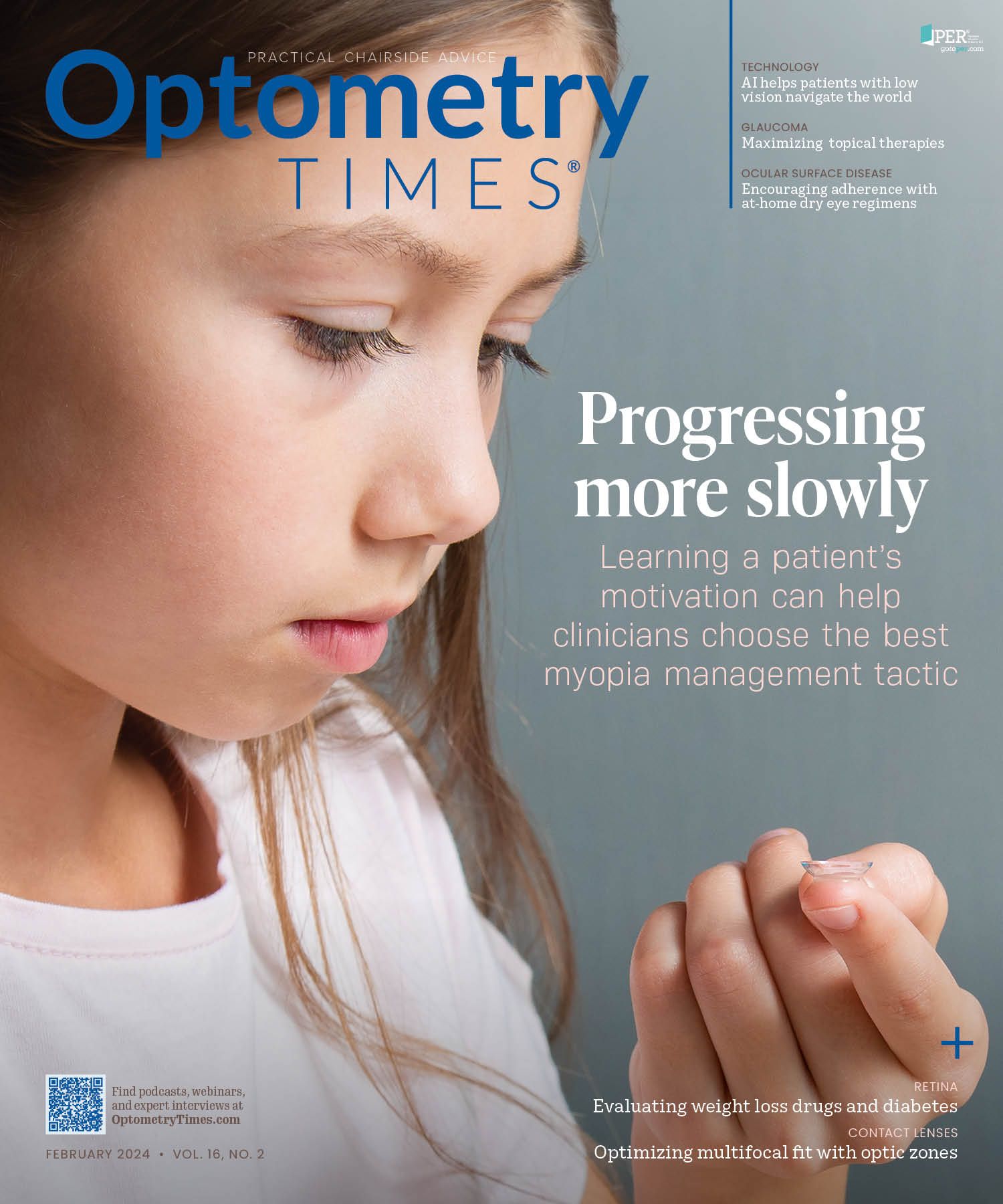As at-home dry eye treatments boom, the importance of compliance rises
Education, together with strong recommendations, in-office retail, habit hacks, and follow-up visits, supports patient compliance.
Image Credit: AdobeStock/NewAfrica

Treatment options for dry eye disease (DED) are exploding with several significant FDA approvals for pharmacological treatments in the last year alone. Many new drugs take aim at specific biological components of the ocular surface to reduce ocular pain and inflammation.1 There has also been a significant amount of research focused on nanotherapeutics and ocular drug delivery systems based on nanotechnology.2
As healthcare providers, we can only take advantage of these new opportunities if we stay informed about advancements. As tough as it is with busy office schedules, we need to carve out time to attend conferences and seminars, read journals, interact with professional associations, take part in continuing education, collaborate with peers, and even check the FDA website for updates on new drug approvals.
As we add more at-home treatments to our armamentarium, patient compliance becomes even more important. We must develop effective tactics to support our patients in getting the most out of their treatment.
A focus on education
As I diagnose and treat my patients, I emphasize education from the very beginning. I find making sure the patient understands their condition as well as the available treatment options to be perhaps the most important factor in enabling them to make good choices and follow through on their commitment to a treatment plan.
During a patient’s routine exam, I look for signs of DED and ask specific questions about any symptoms they may be experiencing. If it appears warranted, I then test for aqueous deficiency, do a lower meibomian gland scan, and run tear breakup tests. If I detect DED, I spend time talking to the patient about the condition and often have them watch videos to help them understand the nature of the disease.
I give the patients a simple action to take at first, such as using over-the-counter artificial tears and I have them come back about 4 weeks later. At this follow-up appointment, I do a comprehensive assessment, and run several tests on the Keratograph 5M (Oculus).
I then talk to the patient about the specific kind of dryness they have – whether it's aqueous deficiency, inflammatory, or meibomian gland dysfunction (MGD). I also tell them that regardless of the root cause, they are going to have all the symptoms: inflammation, irritation, and a breakdown in the tear film. So, we are still going to treat every component of dry eyes.
Non-prescription at-home treatments
Once a patient has been diagnosed with DED, I start them on non-prescription at-home treatments. With my patients, I like to refer to these treatments as “homeopathic.” I find that they are receptive to this terminology, as it makes patients feel like they are using simple, healthy, or less expensive products to get their dry eye under control. I have also found that when patients return to my office and say they have done a lot of the “homeopathic” treatments, but they are still experiencing symptoms, it makes it much easier for me to then write a prescription for a "therapeutic" treatment plan without patient complaint.
I recommend many specific at-home treatment products that have worked well in our practice that the patient cannot find over the counter. I have a form that discusses all of these treatment options and the individual plan I outline for the patient to take home. After the examination, I walk to the front of the office with the patient and put the exact same products I recommend in their hands.
I prefer several of Ocusoft’s products, such as the company’s Hypochlor Spray to remove oil and debris from their eyelids as well as the Oust Demodex Cleanser if I see a proliferation of blepharitis in combination with their dryness. I also give patients the Optase Dry Eye Intense Drops (Scope). It has been a game changer. Patients can use it twice a day and feel comfortable rather than needing to apply OTC drops 4 or 5 times a day.
Many of my patients take home a warm compress that they can heat in the microwave. Any warm compress will work, but the microbead masks will deliver warm, moist heat for 15 minutes consistently.
To encourage behavior changes, I talk to my patients about systemic factors of dry eye. I tell them that we approach that inflammation externally, but we also need to tackle it from the inside out. We talk a lot about diet and the foods that will reduce inflammation in their body.
On top of dietary changes, I like to recommend the nutraceutical HydroEye (ScienceBased Health). The supplement has many different key components that help with the inflammation of dry eye. My patients are often familiar with omega-3 fatty acids, and I tell them the supplement contains the omega-3 fatty acids EPA and DHA from highly pure USP-verified fish oil. I also introduce them to the omega fatty acid GLA derived from black currant seed oil. GLA is not available dietarily in meaningful amounts, and it helps to modulate the body's inflammatory response.3-9
HydroEye has been shown to reduce irritation, support eye comfort and maintain corneal smoothness in a multi-center, placebo-controlled, double-blind trial.10 Since I know that my patients are exposed to a large number of OTC products and often find it challenging to pick out the best solutions on their own, I talk to my patients about the value of choosing products that have been through rigorous clinical trials.
As patients are checking out, I grab the specific products that I have recommended and put the products down in front of my staff members, who know how to explain each item. I have already filled out a form with very specific home care instructions, but my staff still goes over all of this again to reinforce the information with the patient. Then the staff checks the patient out and sets up a follow-up appointment.
The patient now walks away with a strong, specific recommendation from me and clear instructions on how to use the products in their hand. I have found that these measures greatly increase the chances of compliance.
Since I cannot sell everything that my patients might need, I partner with Dry Eye Rescue. The company provides me with a customized form based on the products I recommend, and I can rip off the tear sheet and give it to my patients. Not only does this make it easy for them to buy products that I do not carry, but I also tell patients that if they cannot come into the office to buy refills, they should buy them from Dry Eye Rescue because the company is reputable and handles products properly. They can also get all the products they need from one website, increasing the likelihood that they will follow through with treatment.
I do try to limit the number of products a patient is using at home to no more than 4, to avoid overwhelm. I also offer patients small tricks to help build the habit of using the products, such as putting the drops I want them to use twice a day by their toothbrush or keeping the warm compresses by their bedside.
Turning to pharmaceutical and mechanical treatments
If my patients don’t see the desired results from non-prescription at-home treatments, I will proceed to prescription treatments. The pharmaceutical treatments that I look to most frequently are lifitegrast ophthalmic solution 5% (Xiidra; Bausch + Lomb), cyclosporine ophthalmic emulsion 0.05% (Restasis; Allergan), and cyclosporine ophthalmic solution 0.09% (Cequa; Sun Pharma). Here again, I educate the patient about their condition, explain the treatment I’m recommending, and work with them on techniques to remember to use the product.
If these pharmaceutical treatments are not effective for my patients with MGD, I will then turn to in-office mechanical treatment such as the TearCare System (Sight Sciences) to apply localized heat therapy before manually expressing their meibomian glands.
A long-term commitment to compliance
Even if my patients have undergone therapeutic and mechanical treatment, I let them know that they will need to continue home care. I tell them that if they do not follow through on the treatments I have recommended, be it drops, warm compresses or nutraceuticals, their dry eye will probably come back. People often think that when they start to feel better, their condition has magically improved and they will not need further treatment, but that is not usually the case with a progressive disease such as dry eye.
For this reason, it is vital for ongoing compliance that patients be educated and understand their condition and the importance of their treatments, as well as providing them with tips and tricks that make it easy for them to access and use the treatments available to them.
References:
Coco G, Ambrosini G, Poletti S, et al. Recent advances in drug treatments for dry eye disease. Expert Opin Pharmacother. 2023;24(18):2059-2079. doi:10.1080/14656566.2023.2269090
Nagai N, Otake H. Novel drug delivery systems for the management of dry eye. Adv Drug Deliv Rev. 2022;191:114582. doi:10.1016/j.addr.2022.114582
Kapoor R, Huang YS. Gamma linolenic acid: an antiinflammatory omega-6 fatty acid. Curr Pharm Biotechnol. 2006;7(6):531-534. doi:10.2174/138920106779116874
Macrì A, Giuffrida S, Amico V, Lester M, Traverso CE. Effect of linoleic acid and gamma-linolenic acid on tear production, tear clearance and on the ocular surface after photorefractive keratectomy. Graefes Arch Clin Exp Ophthalmol. 2003;241(7):561-566. doi:10.1007/s00417-003-0685-x
Barabino S, Rolando M, Camicione P, et al. Systemic linoleic and gamma-linolenic acid therapy in dry eye syndrome with an inflammatory component. Cornea. 2003;22(2):97-101. doi:10.1097/00003226-200303000-00002
Brignole-Baudouin F, Baudouin C, Aragona P, et al. A multicentre, double-masked, randomized, controlled trial assessing the effect of oral supplementation of omega-3 and omega-6 fatty acids on a conjunctival inflammatory marker in dry eye patients. Acta Ophthalmol. 2011;89(7):e591-7. doi10.1111/j.1755-3768.2011.02196.x
Aragona P, Bucolo C, Spinella R, Giuffrida S, Ferreri G. Systemic Omega-6 essential fatty acid treatment and pge1 tear content in Sjögren’s syndrome patients. Invest Ophthalmol Vis Sci. 2005;46(12):4474-4479. doi:10.1167/iovs.04-1394
Kokke KH, Morris JA, Lawrenson JG. Oral omega-6 essential fatty acid treatment in contact lens associated dry eye. Cont Lens Anterior Eye. 2008;31(3):141-146. doi:10.1016/j.clae.2007.12.001
Pinna A, Piccinini P, Carta F. Effect of oral linoleic and gamma-linolenic acid on meibomian gland dysfunction. Cornea. 2007;26(3):260-264. doi:10.1097/ICO.0b013e318033d79b
Sheppard JD Jr, Singh R, McClellan AJ, et al. Long-term supplementation with n-6 and n-3 PUFAs improves moderate-to-severe keratoconjunctivitis sicca: a randomized double-blind clinical trial. Cornea. 2013;32(10):1297-1304. doi:10.1097/ICO.0b013e318299549c

Newsletter
Want more insights like this? Subscribe to Optometry Times and get clinical pearls and practice tips delivered straight to your inbox.